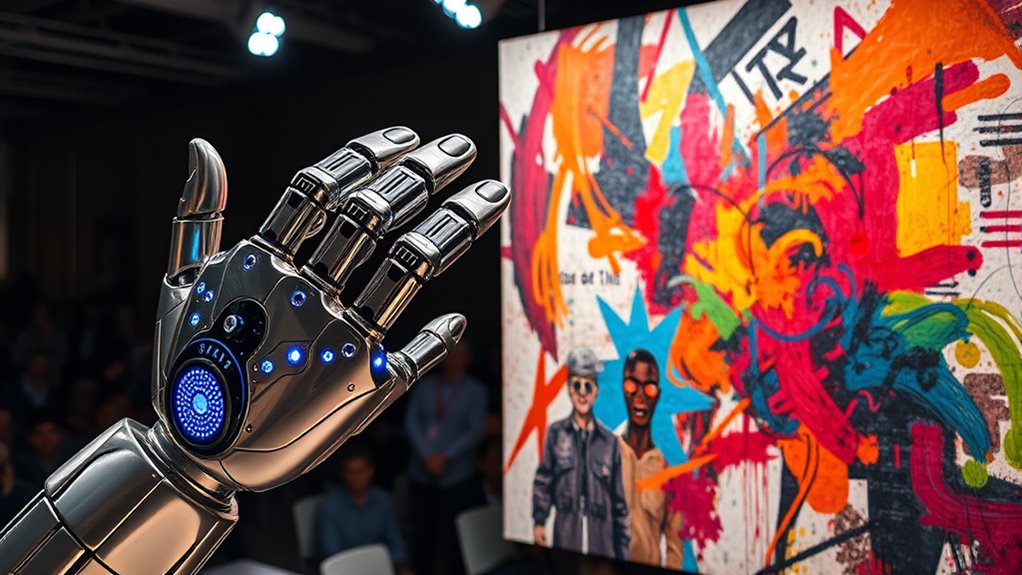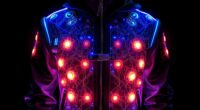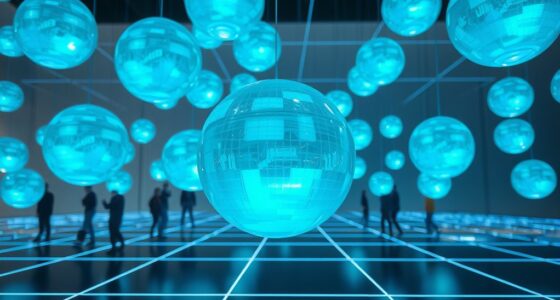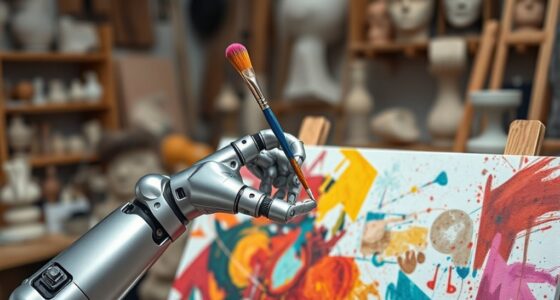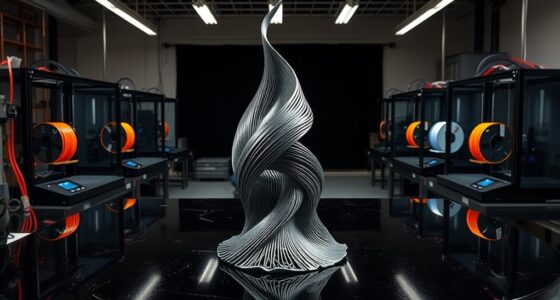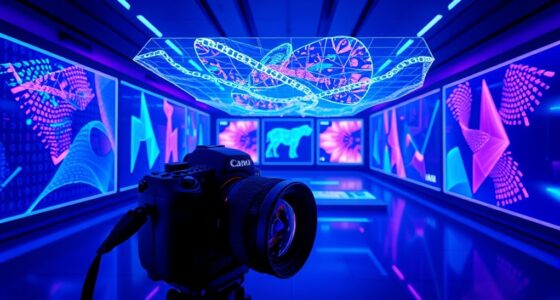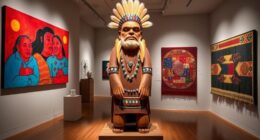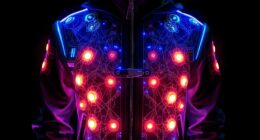In the debate between AI art and human creativity, you see that algorithms often mirror biases from their training data, which can limit originality and reinforce stereotypes. While AI can produce visually impressive work quickly, it struggles to capture the emotional depth and personal stories that make human art meaningful. Human artists draw on cultural experiences and spontaneity, creating authentic emotional connections. Keep exploring to understand how these differences shape the future of artistic expression.
Key Takeaways
- Human creativity is rooted in personal experience and emotional depth, which AI struggles to authentically replicate.
- Algorithm biases can limit AI-generated art’s diversity, leading to repetitive or stereotypical outputs.
- AI can assist and enhance human creativity but lacks the genuine emotional expression integral to meaningful art.
- Human artists convey intention and cultural context, making their work more emotionally resonant than AI-generated pieces.
- The debate centers on AI as a tool that complements human creativity, not as a replacement for authentic emotional and cultural expression.
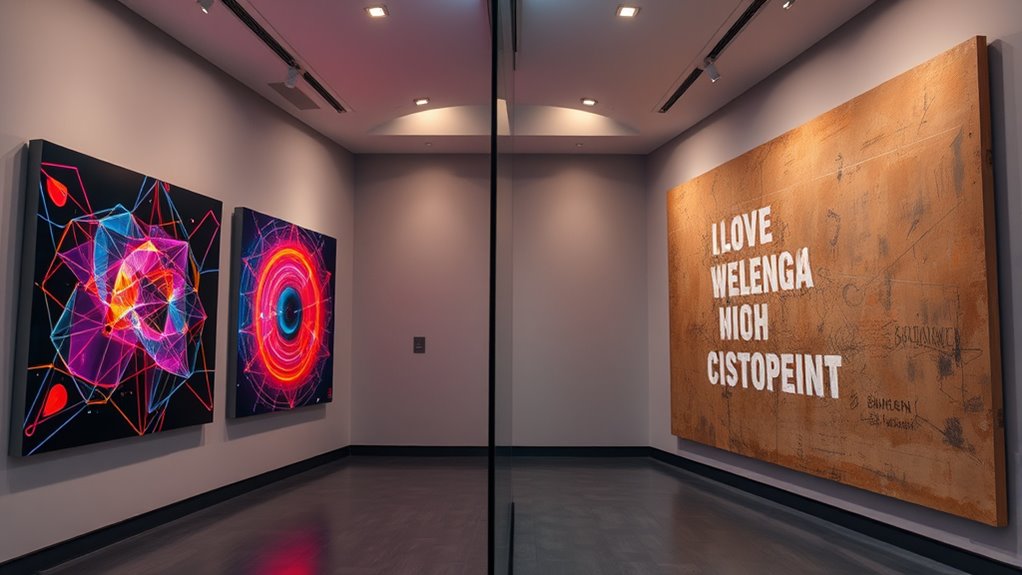
Artificial intelligence has revolutionized the way art is created, blurring the lines between human ingenuity and machine-generated work. As you explore AI art, you might notice that algorithms often reflect biases embedded in their training data, known as algorithm bias. This bias can lead to repetitive or stereotypical results, which may limit the diversity and originality you seek in art. While AI can produce impressive visuals quickly, it sometimes struggles to capture the emotional depth that human artists naturally infuse into their work. You may find that AI-generated pieces lack the nuanced feelings and personal experiences that make human art resonate on a deeper level. This gap raises questions about whether machines can truly understand or express complex human emotions, or if they merely mimic surface-level appearances.
When you compare AI art to human creativity, it’s clear that the emotional depth in human work stems from lived experiences, cultural context, and personal stories. You can feel the artist’s intention and emotional journey through their brushstrokes or composition, something that AI currently can’t replicate authentically. AI tools might generate images that appear emotionally evocative, but they often lack the genuine emotional connection that drives human artists to create their best work. This is not to say AI can’t evoke feelings at all, but the authenticity and spontaneity of human emotion are difficult for algorithms to emulate convincingly. As a result, some argue that AI art remains a technical achievement rather than a truly meaningful form of expression.
Despite these limitations, AI’s ability to analyze vast datasets and generate art at unprecedented speeds opens new creative possibilities. You can use AI as a collaborative partner, enhancing your ideas or providing inspiration. However, it’s important to recognize that algorithm bias can influence the output, sometimes skewing the creative process or limiting originality. The emotional depth in human-created art often reflects personal struggles, joys, or cultural nuances that AI cannot fully understand or replicate. Additionally, advancements in home theater projectors demonstrate how technology can enhance visual experiences, highlighting the importance of technological tools in creative and entertainment contexts. As you navigate this landscape, you might appreciate AI as a tool that complements human creativity rather than replaces it, emphasizing the unique capacity of humans to bring emotional richness to art. Ultimately, the debate centers on whether machines can truly replicate the depth of human feeling or if their creations will always serve as impressive, yet ultimately superficial, reflections of human experience.
Frequently Asked Questions
Can AI Truly Understand the Emotional Depth of Art?
AI can’t truly grasp the emotional depth of art because it lacks emotional authenticity and artistic intuition. While AI can mimic styles and generate compelling visuals, it doesn’t experience feelings or personal insights like humans do. You might find AI-created art emotionally resonant, but it doesn’t come from genuine understanding. Ultimately, AI lacks the inner emotional connection that makes human art profoundly impactful and authentic.
How Do Copyright Laws Apply to Ai-Generated Artwork?
You should know that copyright laws for AI-generated artwork are still evolving, with 25% of legal experts unsure about ownership rights. These laws address legal implications and ownership disputes, often challenging who owns the art—the creator or the AI. As a result, you might face complex questions about licensing and rights, making it essential to stay updated on legal developments to protect your work and avoid potential disputes.
Will AI Replace Human Artists in the Future?
AI won’t fully replace human artists because machine originality lacks the emotional depth and personal touch that define artistic authenticity. You bring unique experiences and intuition to your work, creating pieces that resonate on a deeper level. While AI can assist and inspire, it can’t replicate the human spirit behind true creativity. Your originality and authenticity remain irreplaceable, making your art meaningful in ways machines can’t achieve.
What Skills Are Essential for Future Artists?
Did you know that 85% of employers value creativity more than technical skills? As a future artist, you need to hone your artistic intuition and technical proficiency. These skills help you innovate, adapt, and connect emotionally with your audience. While technology evolves, your ability to trust your instincts and master techniques will distinguish you and guarantee your work remains meaningful and unique in an ever-changing landscape.
How Does AI Influence Cultural Diversity in Art?
AI influences cultural diversity in art by expanding access to diverse cultural representation, allowing you to explore different traditions and perspectives. It helps preserve artistic authenticity by remixing and reimagining cultural elements in new ways. You can create more inclusive, globally aware art that celebrates varied backgrounds, making cultural diversity more visible and appreciated. However, staying mindful of authentic representation remains essential to guarantee AI enhances rather than diminishes cultural richness.
Conclusion
As you consider the debate, remember that AI-generated art now accounts for over 20% of new digital creations, highlighting its growing influence. While AI can produce stunning images quickly, human creativity brings unique emotions and personal stories to life. Ultimately, it’s not about replacing artists but enhancing your creative possibilities. Embrace both, and you’ll see how technology and human passion together can push art into exciting new frontiers.

